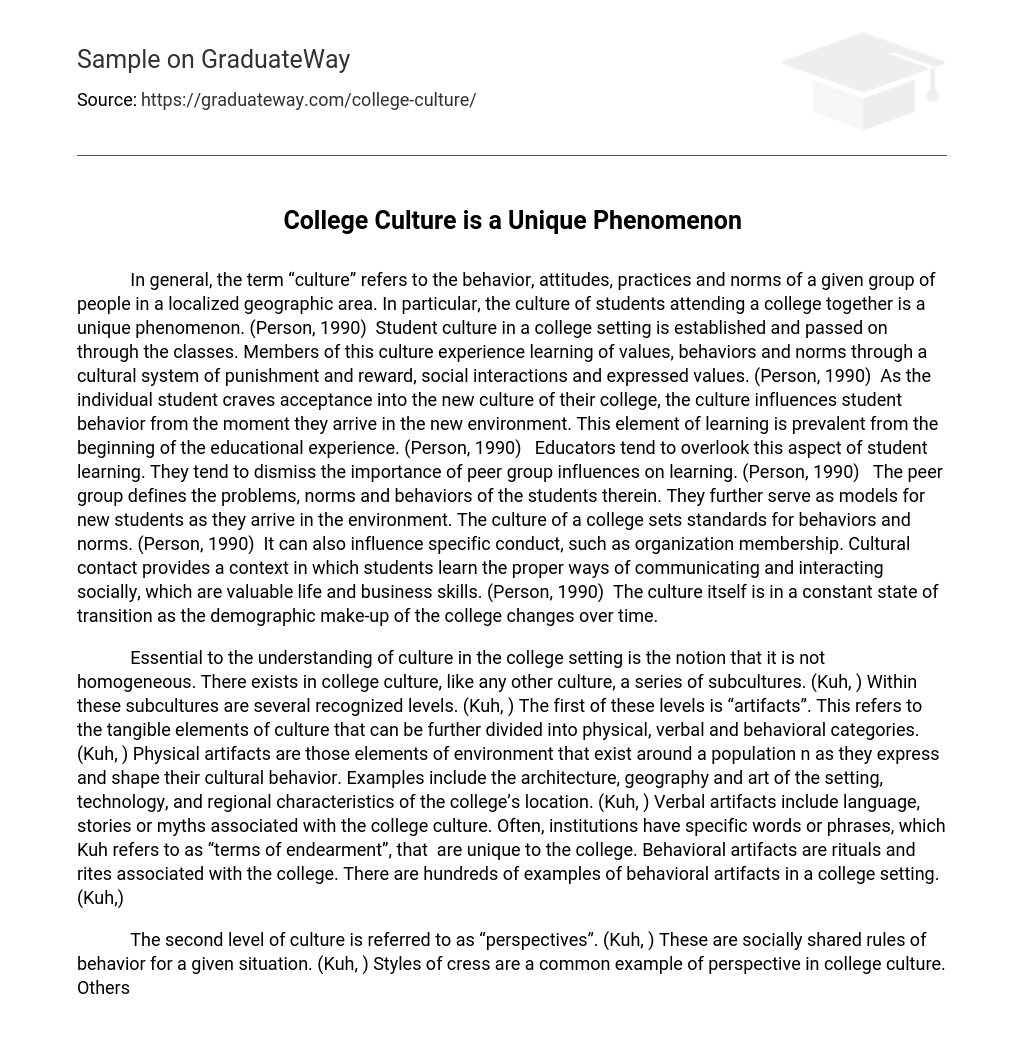In general, the term “culture” refers to the behavior, attitudes, practices and norms of a given group of people in a localized geographic area. In particular, the culture of students attending a college together is a unique phenomenon. (Person, 1990) Student culture in a college setting is established and passed on through the classes. Members of this culture experience learning of values, behaviors and norms through a cultural system of punishment and reward, social interactions and expressed values. (Person, 1990)
As the individual student craves acceptance into the new culture of their college, the culture influences student behavior from the moment they arrive in the new environment. This element of learning is prevalent from the beginning of the educational experience. (Person, 1990) Educators tend to overlook this aspect of student learning. They tend to dismiss the importance of peer group influences on learning. (Person, 1990)
The peer group defines the problems, norms and behaviors of the students therein. They further serve as models for new students as they arrive in the environment. The culture of a college sets standards for behaviors and norms. (Person, 1990) It can also influence specific conduct, such as organization membership. Cultural contact provides a context in which students learn the proper ways of communicating and interacting socially, which are valuable life and business skills. (Person, 1990) The culture itself is in a constant state of transition as the demographic make-up of the college changes over time.
Essential to the understanding of culture in the college setting is the notion that it is not homogeneous. There exists in college culture, like any other culture, a series of subcultures. (Kuh, ) Within these subcultures are several recognized levels. (Kuh, ) The first of these levels is “artifacts”. This refers to the tangible elements of culture that can be further divided into physical, verbal and behavioral categories. (Kuh, )
Physical artifacts are those elements of environment that exist around a population n as they express and shape their cultural behavior. Examples include the architecture, geography and art of the setting, technology, and regional characteristics of the college’s location. (Kuh, ) Verbal artifacts include language, stories or myths associated with the college culture. Often, institutions have specific words or phrases, which Kuh refers to as “terms of endearment”, that are unique to the college. Behavioral artifacts are rituals and rites associated with the college. There are hundreds of examples of behavioral artifacts in a college setting. (Kuh,)
The second level of culture is referred to as “perspectives”. (Kuh, ) These are socially shared rules of behavior for a given situation. (Kuh, ) Styles of cress are a common example of perspective in college culture. Others include public discussion taboos, procedures at faculty meetings and other behavioral standards. (Kuh, )
”Values”, the third level of subcultures is the group’s impression of the ideal in circumstances, the way things “aught to be”. (Kuh, ) many colleges express values in the form of mission statements and/or policy/conduct guidebooks. (Kuh,) Values may be espoused or enacted. If they are merely espoused, they make the claim of being a value without reflecting the reality of attempting to fulfil the value. If they are enacted, the culture is making a real effort to have cultural behavior conform to the stated values.
The final level of subculture is “Assumptions”. These are tacit beliefs used by members of the culture to define their roles and behaviors. (Kuh, ) These are implicit tenets upon which artifacts, perspectives and values are based. (Kuh, ) These assumptions can be further divided into five subsets. One of these is humanity’s relationship to nature. A second is ***These pages of the KUH article have been omitted from the copy you uploaded***(pg 8-9).
In the culture of a college setting, it is rare that a single culture dominates. The fabric of the culture of a college consists of numerous subcultures. These subcultures define themselves similarly to general cultures, using language, behavior and other cues to differentiate from the “rest of the group”. (Kuh, ) Subcultures can exist among both students and faculty. A typical division of the culture of faculty is by department of study. (Kuh, ) The interactions between students, their culture and their subculture define a key element of their learning and development at college.
The elements of culture described above can be understood through a method of inquiry known as the Cultural Audit. (Whitt, ) The Cultural Audit is a journey to understand the culture of a particular location, such as a college, and the process is guided by eight principles. (Whitt, ) The first of these is that the auditor must identify and acknowledge the underlying assumptions of the subject as to what culture is. The second principle is to respect the uniqueness of the institution being audited. (Whitt, )
The third principle is that the Auditor recognizes the need to explore the perspectives of both the insiders and the outsiders. The fourth principle is that a full engagement requires a lengthy interaction. (Whitt, ) Fifth is the principle that the Auditor should get as much information as possible before formulating conclusions.
The sixth principle is acknowledging the fact that the institution may resist the audit. (Whitt, ) The seventh principle that an Auditor should recognize is the necessity of multiple forms of data collection. The final principle of the Culture Audit is that the Auditor should obtain insider feedback on their observations and conclusions to ensure accuracy. (Whitt, )
The use of the Culture Audit should be an effective way to examine culture at Queens College in Flushing, Queens. Part of the City University of New York (CUNY), Queens College boasts nearly 18,500 students. It maintains a good reputation for academic achievement, and is classified as a commuter college, since 40% of the undergraduates and 90% of the graduate students are part-time. The school sponsors 20 men’s and women’s Division II sports teams. The school boasts students from 120 different nations, who speak 66 different languages.





